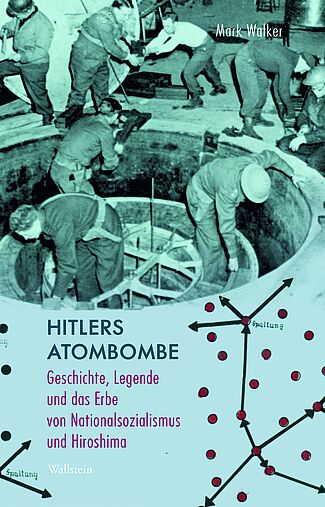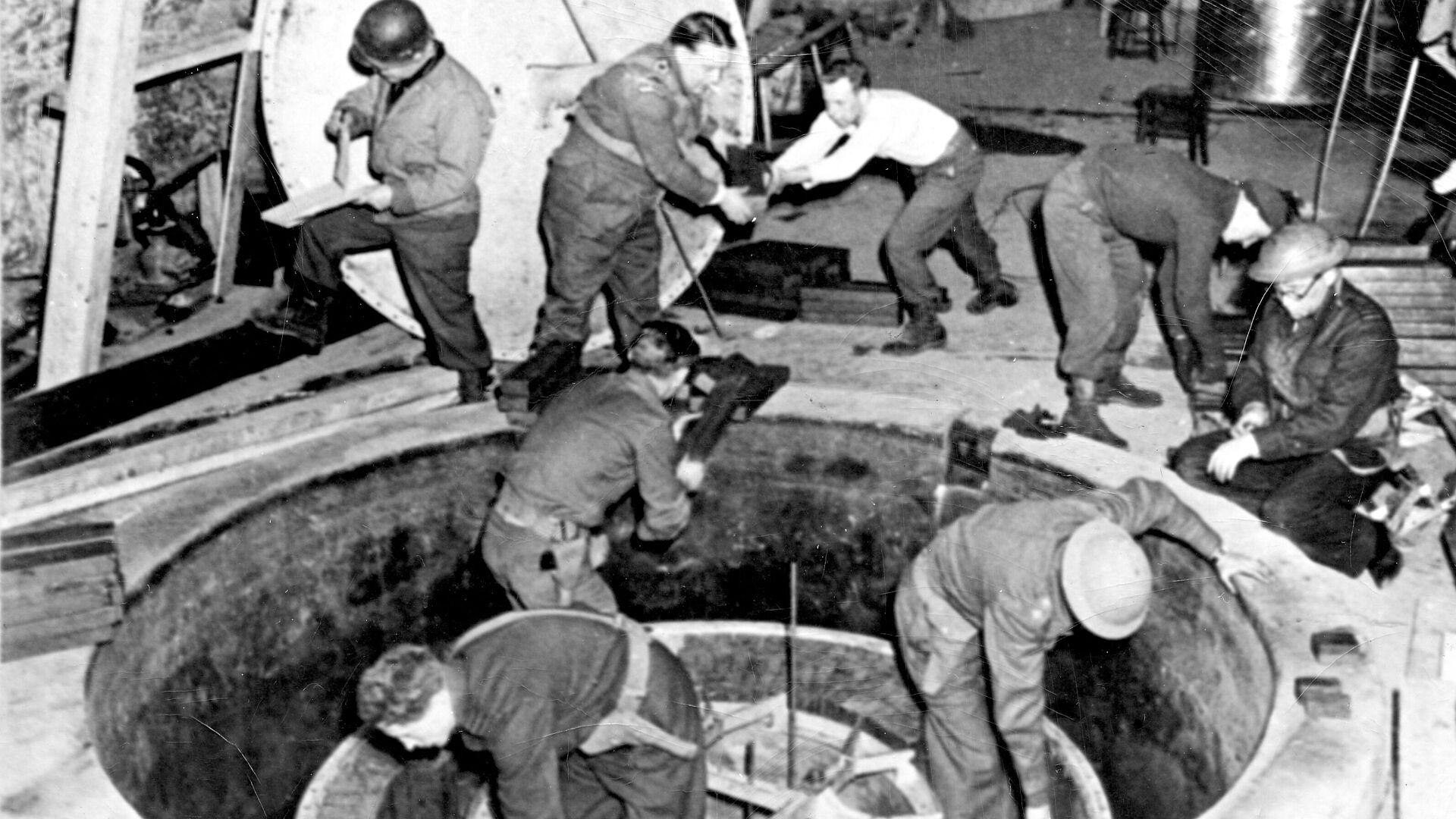
Hitlers Atombombe
Legenden um eine Uranforschung im NS-Staat wirken bis heute nach. Mark Walker analysiert sowohl die Geschichte um »Hitlers Atombombe« als auch ihre Aufarbeitung in der Nachkriegszeit.

Stories from science , Stories from science
from Mark Walker
Legends surrounding uranium research in the Nazi state continue to have an impact to this day. From the beginnings of research into nuclear fission to the German uranium project during the Second World War and its impact in the post-war period, Mark Walker vividly summarizes the current historical findings.
During the winter of 1938/1939, the German chemists Otto Hahn and Fritz Strassmann, aided by the exiled Austrian physicist Lise Meitner, discovered that when uranium nuclei are bombarded by neutrons, they sometimes “fission,” splitting into several pieces.
This immediately ignited an international race to understand this process. Within a year and a half it was clear that fission released energy and further neutrons, making a “chain reaction” possible. Moreover, while the rare isotope uranium 235 was easy to fission, the much more common isotope 238 could absorb a neutron and transform into a transuranic element, which just like uranium 235 would be easy to fission. The stage was thereby set for an international race to harness nuclear fission for energy production and weapons.
Schematic drawing of a Leipzig experiment with spherically arranged layers of heavy water and uranium powder. From: Döpel, H. u. K; Heisenberg, W.: "Die Neutronenvermehrung in einem D2O-38-Metallschichtensystem." In: Nutzbarmachung von Atomenergien. Heft 3. Geheime Forschungsberichte (März 1942), S. 3. Deutsches Museum Archiv, FA 002/735. Photo: Deutsches Museum Archiv, CC BY-SA 4.0 | Deutsches Museum Archiv, CC BY-SA 4.0
During the “Lightning War” (Blitzkrieg) phase - from the German attack on Poland in September, 1939 to the autumn of 1941, when the invasion of the Soviet Union ground to a halt - a few dozen German scientists researched uranium isotope separation and experimented with model nuclear reactors, including searching for the most effective materials. Only modest progress was made, but during this phase of the war Germany did not appear to need powerful new weapons.
In late 1941 it was clear that the German war economy needed to be restructured and more efficient. Army Ordnance, which had established the “nuclear physics working group,” determined that the research could not influence the outcome of the war and transferred the project to a civilian agency, the Reich Research Council. The scientists recognized that, in order to continue receiving support and to avoid being called up for front-line military service, they had to convince political and military leaders of the importance of their work.
Werner Heisenberg used this diagram in a talk for political leaders that vividly described uranium 235 and the new transuranic element 94 (plutonium) as explosives of “of utterly unimaginable effect.” While the left side is a schematic diagram of a nuclear reactor, the right side shows a nuclear fission chain reaction in a pure mass of uranium 235 or element 94, in other words the heart of an atomic bomb. Although the physicist did not promise to deliver nuclear weapons in time to help Germany win the war, he did argue successfully that, because the Americans were probably working on this, Germany needed to continue its research. The uranium research subsequently received strong support from Armaments Minister Albert Speer and others.
Whereas up until the summer of 1942 the American and German atomic bomb projects were comparable and had achieved similar results, thereafter the increasing destructive effects of the war in Germany made research difficult, and sometimes impossible. It was precisely during this period that the Americans made massive investments in industrial facilities and a new secret weapons lab in Los Alamos, New Mexico.
In the end, the Germans came close, but fell short of separating the uranium isotopes and building an operating nuclear reactor.
At the end of the war, ten scientists were arrested and interned in an English country house named Farm Hall. The building had secret microphones in the walls, so that the scientists’ conversations were overheard and recorded.
When Werner Heisenberg was questioned after the war, Samuel Goudsmit, a Dutch physicist and naturalized American citizen, led his German colleague to believe that the Americans had not worked on uranium during the war. As a result, for a brief time the Germans believed that their wartime work would be very valuable to the Allies. When they heard the news of the attacks on Hiroshima and Nagasaki on the radio in Farm Hall, they suddenly realized that their research was now second class. The scientists also began debating first, whether they could have built atomic bombs, and second, whether they would have wanted to do so.
Once Heisenberg and his colleagues returned to West Germany, they had to face public scrutiny. Had they tried to give Adolf Hitler atomic bombs? Did they fail to help Germany win the war? Had they compromised with National Socialism?
In response, Heisenberg, Carl Friedrich von Weizsäcker and others began reconstructing and reinterpreting their actions during the Third Reich. First of all, they correctly argued that it had not been possible for Germany to build nuclear weapons during the war. Next Heisenberg and Weizsäcker claimed that, during a trip to occupied Denmark in September, 1941, they had sought to enlist the help of Heisenberg’s mentor Niels Bohr in order to persuade Allied physicists not to create atomic bombs. This international “strike” of nuclear scientists would have stopped the development of all nuclear weapons.
This “legend of Copenhagen” was publicized by Robert Jungk’s best-selling book Brighter than a Thousand Suns, first published in 1956. A year later, eighteen prominent scientists, including Heisenberg and Weizsäcker, issued the “Göttingen Declaration,” publicly stating that they would have nothing to do with the development of West German nuclear weapons.
The Göttingen Declaration and Jungk’s book reinforced each other. The public refusal by the eighteen scientists to help Adenauer’s government to acquire nuclear weapons made more plausible Jungk’s claim that, during the Third Reich, Heisenberg, Weizsäcker, and their colleagues had not wanted to build atomic bombs. In turn the book made these scientists appear consistent: both under National Socialism and in the new West German Federal Republic they supported civilian research on nuclear fission, not military.
However, when Heisenberg and Weizsäcker’s 1941 visit with Bohr is placed in the context of how much scientific progress the German uranium project had made by that time and their conduct while travelling abroad during the war, including, but not limited to Copenhagen in 1941 is scrutinized, then they do not appear to be trying to forestall all nuclear weapons. Instead Heisenberg told Bohr that atomic bombs were feasible and the Germans were working on this because he hoped to gain information about how much progress the Americans had made. He and Weizsäcker were afraid of American atomic bombs falling on Germany.